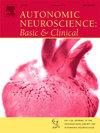体位改变后,年龄和体位性低血压与压力反射敏感性和脑氧合有关
IF 3.3
4区 医学
Q2 NEUROSCIENCES
引用次数: 0
摘要
压反射敏感性(BRS)、维持血压(BP)和脑自动调节、维持脑血流量(CBF)是抵消姿势相关的血压变化及其对CBF影响的调节机制。这些机制可能在诸如直立性低血压(OH)等老年疾病中失效,并引起症状和跌倒。本研究旨在确定体位改变后BRS和脑氧合与年龄、性别、降压药使用、合并症和OH的关系。34名年轻人(中位年龄25岁)、30名老年人(中位年龄77岁)和41名老年门诊患者(中位年龄76岁)进行了2-3次仰卧-站立转换,同时连续测量心率(心电图)、BP(容积钳光容积脉搏波)和脑氧合(近红外光谱)。在时域和频域上测定BRS、脑氧合和脑自动调节。采用线性回归和组间比较研究相关关系。较高的年龄和OH的存在(连续血压测量期间至少有一次仰卧-站立转换中的OH)与较低的BRS相关(每年1%,当有OH时为30%)。年龄越大,30s后脑氧恢复越快(每年0.1 μmol/L),而OH与体位改变后1min脑氧恢复越慢(有OH时为1.3 μmol/L)相关。在所有三组中均未发现大脑自动调节功能受损的证据。特别是OH患者的BRS降低和脑氧恢复与他们对脑缺氧的易感性一致。大脑自动调节作为BRS失败的代偿机制的作用尚未得到证实。本文章由计算机程序翻译,如有差异,请以英文原文为准。
Age and orthostatic hypotension are associated with baroreflex sensitivity and cerebral oxygenation after postural change
Baroreflex sensitivity (BRS), maintaining blood pressure (BP), and cerebral autoregulation, maintaining cerebral blood flow (CBF), are regulatory mechanisms to counteract posture-related BP changes and their effect on CBF. These mechanisms may fail in geriatric conditions such as orthostatic hypotension (OH) and cause symptoms and falls. This study aimed to determine the association of age, sex, antihypertensive use, comorbidity, and OH with BRS and cerebral oxygenation after postural change.
Thirty-four younger adults (median age 25 years), 30 older adults (median age 77 years), and 41 geriatric outpatients (median age 76 years) performed 2–3 supine-stand transitions, while heart rate (electrocardiogram), BP (volume-clamp photoplethysmography), and cerebral oxygenation (near-infrared spectroscopy) were measured continuously. BRS, cerebral oxygenation and cerebral autoregulation were determined in the time and frequency domain. Associations were investigated using linear regression and group comparisons.
Higher age and presence of OH (OH in at least one supine-stand transition during a continuous BP measurement) were associated with lower BRS (1 % per year, 30 % when having OH). Higher age was associated with higher cerebral oxygenation recovery (0.1 μmol/L per year) after 30 s, while OH was associated with lower cerebral oxygenation recovery (1.3 μmol/L when having OH) at 1 min after postural change. No evidence of cerebral autoregulation impairment was found across all three groups.
Reduced BRS and cerebral oxygenation recovery specifically in participants with OH are in line with their assumed susceptibility to cerebral hypoxia. The role of cerebral autoregulation as a compensatory mechanism for failing BRS could not be confirmed.
求助全文
通过发布文献求助,成功后即可免费获取论文全文。
去求助
来源期刊
CiteScore
5.80
自引率
7.40%
发文量
83
审稿时长
66 days
期刊介绍:
This is an international journal with broad coverage of all aspects of the autonomic nervous system in man and animals. The main areas of interest include the innervation of blood vessels and viscera, autonomic ganglia, efferent and afferent autonomic pathways, and autonomic nuclei and pathways in the central nervous system.
The Editors will consider papers that deal with any aspect of the autonomic nervous system, including structure, physiology, pharmacology, biochemistry, development, evolution, ageing, behavioural aspects, integrative role and influence on emotional and physical states of the body. Interdisciplinary studies will be encouraged. Studies dealing with human pathology will be also welcome.

 求助内容:
求助内容: 应助结果提醒方式:
应助结果提醒方式:


